
|
|||
|---|---|---|---|
|
|
Formation of middle and long distance junior runners of the Ecuador’s Andean region La formación de los corredores menores de distancias medias y largas de la región andina ecuatoriana |
|
|
|
*Universidad de Ciencias de la Cultura Física y el Deporte “Manuel Fajardo” (Cuba) **Universidad de las Fuerzas Armadas ESPE Departamento de Ciencias Humanas y
Sociales (Ecuador) |
MSc. Édison Andrés Castro Pantoja* Dr.C. Edgardo Romero Frómeta** Dr.C. Isabel Fleitas Díaz* Dr.C. Sergio Raúl Carrillo Cabiedes* MSc. Edison Santiago Guerrero González*** |
|
|
|
Abstract This paper aims to offer preliminary results through a survey applied to middle and long distance Ecuadorian coaches, in order to diagnose some knowledge related to the altitude training in middle and long distance junior runners. The survey was applied a sample of 125 coaches registered in the IAAF level one course, and to eight experts that assessed the proposal by studying variables such as the age and years of experience of the coaches; average number of athletes under their training; number of available digital pulsometers, weeks needed for the annual macrocycle; training structure of the macrocycle; load dynamics of the mesocycle; training methods, training systems for the development of aerobic resistance; distribution of the work with the physical abilities, and the competitive distances recommended for the coaches. Keywords: Athletics. Middle and long distances. Altitude training. Ecuador.
Resumen El objetivo de la investigación es ofrecer resultados preliminares a través de la técnica de encuesta, aplicada a los entrenadores ecuatorianos de distancias medias y largas, dirigidos a diagnosticar algunos conocimientos relacionados con el entrenamiento en la altura en corredores menores de distancias medias y largas. La encuesta fue aplicada como fase diagnóstico a una muestra de 152 entrenadores inscritos en el curso nivel I de la IAAF, y ocho expertos que valoraron la propuesta, estudiándose las variables edad y años de experiencia de los entrenadores encuestados, número promedio de deportistas que entrenan, número de pulsómetros digitales disponibles, semanas utilizadas en el macrociclo anual, estructura de entrenamiento en el macrociclo anual, dinámica de la carga en el mesociclo, métodos de entrenamiento, sistemas de entrenamiento para el desarrollo de la resistencia aerobia, distribución del trabajo realizado en la capacidades físicas, y las distancia competitivas recomendadas por los entrenadores. Palabras clave: Atletismo. Distancias medias y largas. Entrenamiento en la altura. Ecuador.
Reception: 06/16/2016 - Acceptance: 08/09/2016
1st Review: 07/28/2016 - 2nd Review: 08/05/2016
|
|||
|
|
EFDeportes.com, Revista Digital. Buenos Aires, Año 21, Nº 219, Agosto de 2016. http://www.efdeportes.com |
|
|
1 / 1
Introduction
It's scientifically demonstrated that the exposition to altitude combined with the training near the sea level improves the performance by increasing the transport of oxygen to the muscles (Virués-Ortega, Garrido, Javierre, & Rivero, 2008; Campo, Sánchez, García, Arias, Albizu, & Díaz, 2012; Rusko, Tikkanen, & Peltonen, 2016). The best height for a daily exposition of 20 hours is around 2100 to 2500 meters (Erdmenger, 2013; Girard, Amann, Aughey, Billaut, Bishop, Bourdon et al., 2013; Yang, Yin, Qian, & Jiang, 2015). There is a great variation in the benefits for the athlete during altitude training, which will depend on the optimization level of the direction of the sport training process (Calero, 2014a,b), yet Calero (2013) considers that such training is one of the worldwide trends of the current sport training process, which makes essential the study of the main variables of the sport training in order to reach high and prolonged results in any sport.
The altitude exposition can be included in the set up of the training program or in the end of the preparatory phase (Jenkins, 2001; Wilber, 2004; Plowman, & Smith, 2013). A potential nutritional problem is the loss of muscle mass as result of an insufficient ingestion of calories (Bigard, Brunet, Guezennec, & Monod, 1991; Chapman, Stickford, Lundby, & Levine, 2014). Iron deficiency can also reduce the benefits of the altitude exposition, that’s why it is recommended to increase this mineral, as it is affirmed by Hallagan, & Pigman (2004). Hyperbaric chambers, nitrogen houses and tents seem to successfully simulate the exposition to altitude. The use of supplementary oxygen to train at a high intensity in altitude appears to be more successful than the training in a low ground.
Despite knowing these elements and having five high-performance centers with state-of-the-art technologies, Ecuador has not registered satisfactory results in Olympic or world middle and long distance events. The problem of the paper leads to the existence of limitations detected in the sport training process of the middle and long distance runners that train in altitudes.
The scientific novelty is given in the program on proposal, which includes a new way of altitude training in Ecuador, since it establishes a combination of methods, means and procedures that develop the relational dynamics of the training in coordination with the energetic and functional systems that regulate the development of the resistance and the practical significance, therefore it proposes a model that gives detailed information about the altitude training process for junior categories. This model includes a precise description of each part of the training in conditions of hypoxia. It constitutes a practical and secure means for coaches that intend to establish a correct organization and evaluation of the training process.
Terrados (1994, cited by Pérez, 2005) makes reference to some aspects that should be taken into account while being in an altitude:
-
The barometric pressure; which is the essential physical effect in the altitude. The atmospheric pressure and density diminish with the height, which leads to a reduction of the partial oxygen pressure both in the air and in the oxygen pressure of the arterial blood, causing hypoxia. It means that the molecule of oxygen makes less pressure to reach the blood, for which it is, produced a relative lack of oxygen (hypoxia).
-
Temperature, which descends with altitude approximately 1º C per 150 meters above the sea level.
-
Air relative humidity: the amount of water vapor in the air reduces with altitude faster than the barometric pressure. The water of the body is lost, hence dehydration.
-
Infrared and ultraviolet solar radiation; in an altitude it increases in 2 to 4 % per 100 meters to 2000 meters and then it increases in 1 %.
-
Gravity force diminishes, for which the flying time and the distance covered by a body is higher in altitude than at the sea level.
-
The air resistance diminishes when the barometric pressure diminishes. This makes possible to breathe easier, since the respiratory muscles have to beat a minor resistance of the air ways. At the same time, there is less resistance for the runner to advance.
-
Altitude tolerance with the age: is recommended for juniors who regularly train under 1000 meters.
Short term: the most important factor on the organism is the reduction of the partial pressure of oxygen in the air breathed (PO2) (Askew, 2002; Girard, y et al, 2012) and at the same time, of the oxygen blood pressure, according to Cordoba & Martínez-Villén (2001), the immediate adaptive response, hyperventilation and the increase of the heart rate (HR).
The increase of the blood flow, intends to avoid repercussions on the oxygenation of the muscles (Insua, 2003; Herrera, & Díaz, 2006; Calero y González, 2015), while the total amount of oxygen remains constant. Nevertheless, the reduced support, which must be compensated, conditions the ability to do the exercise reducing the maximum consumption of oxygen (VO2 max).
Long term: Both hyperventilation and the increase of the heart rate (HR) lead to changes in the acid-base balance (de Paula, Hidalgo, Toranzo, Doza, & de Paula, 2012), causing a chronic drop of the CO2 concentration (respiratory alkalosis by hyperventilation). However, this affects the physical ability in a negative way (Córdoba y Martínez-Villén, 2001).
In this phase, the most important adaptation for the altitude sport training is the increase of red globules and of the concentration of haemoglobin to raise the oxygen transport capacity to the blood and therefore, the amount of oxygen to the muscle also increases. Likewise, there are cellular changes to favour the oxygen contribution to the muscle: it raises the capillarity, the myoglobin, the mitochondria and the enzymes necessary to obtain aerobic energy (Córdoba y Martínez-Villén, 2001).
These authors mention that there are counter-productive responses, such as the loss of muscle mass due to hypoxia in altitudes and during long exposition periods.
Córdoba & Martínez-Villén (2001) suggest that as a general goal is necessary to search for ways to contribute to the improvement of the altitude training process of middle and long distance runners in junior categories (13 and 15 years) of the Ecuador Andean region, by limiting the research to design a basic training program for middle and long distance junior runners of the region with special focus on the “altitude training of middle and long distance runners”. The methodological conception of the paper is reflected from the stages recommended by Álvarez de Zayas (1995).
According to Hausleber (Wikipedia, 2015), with the put in practice of this measures in Mexican race walkers, there is an improvement from 3 to 4% in 20 kilometres race walkers and from 6 to 8% in 50 kilometres race walkers. He considers that by training in big altitudes the same intensity of the work is registered but covering a shorter distance than in minor heights or by the sea level. This makes possible that during the training load the intensity increases and the volume decreases. That is to say, to obtain the same stimulus on the cardio respiratory system it is covered a distance shorter than at sea level (fewer steps). Thus, the joints, muscles and bones are undergone to a lower number of traumatisms and the possibility of injury decreases. For example, 20 km at 4 000 m is the equivalent to 30 km at 2000 m and to 40 km at the sea level (Lucía, 2000).
This paper is aimed at offering preliminary results based on the results of a survey applied to Ecuadorian coaches of middle and long distances in order to diagnose the status of the problem in the nation.
Material and methods
The main methods applied during the investigation are, in the theoretical level, the systemic-structural and functional method, which allowed establishing a structure-function relation among the components of the program. Likewise, through the logical process of the mind we used the following methods: synthetic analytic, inductive-deductive, generalization, among others, through which it was possible to analyze and sum up the conceptions related to the object of study and to get to conclusions after completing the methodology.
In the case of the empirical inquiries were used other methods such as the revision of official documents, which allowed consulting the Programa de Preparación Integral del Deportista de Atletismo Cubano (Program for the Comprehensive Athlete Preparation of Cuban Athletics), among others, in order to analyze training variants and adapt them to altitude training; the survey was used to find information about the mechanisms coaches have to control the training of their runners; the experts criteria, for the specialised assessment of the program proposed in the paper.
The study takes place in the Andean provinces of Carchi, Imbabura, Pichincha, Tungurahua, Chimborazo, Azuay, Tungurahua, with federate athletes (registered in the data base of the corresponding provincial federations) in a total of 100 athletes. It was also taken into account a sample of 152 coaches registered in the level 1 IAAF course that participate in the survey and eight experts that assessed the proposal.
Results and discussion
Characteristics of the sample: Group of coaches mostly aged 27-33 years and 33-40 years (graphic 1), followed by 14,6% aged 41-47 years and 12.5% under 27.
The diagnosis allowed analyzing the reality and detecting significant aspects about the ways to work with long distance runners in Ecuador.
Graphic 1. Ages of the coaches surveyed
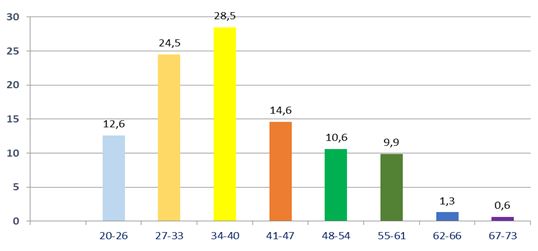
It was found that 53% of the coaches are aged 27-40 years, and by adding this figure to those aged 41-47 years, then most of the coaches are aged 27-54 years, with 87.2%, a higher figure if to that 53% is added 12,6% aged 20-26 years, which would be 65,6%.
These data show that Ecuadorian coaches dedicated to train middle and long distances junior runners are mature as for the age.
In that regard, their personal experience is found, in most cases, in a range of 10 to 19 years of work (graphic 2). However, the right part of the graphic, from 10 t 14 years of experience indicates favourable data by setting a balance of the figures of the accumulated percentage until nine years of experience and more, so it is visible that 74,2% of the coaches shows, in a positive way, to have among 10 and 40 years of experience. An effective fact, since the experience with the management of training loads will be well assimilated and will have short and long term results.
Graphic 2. Years of experience as coaches
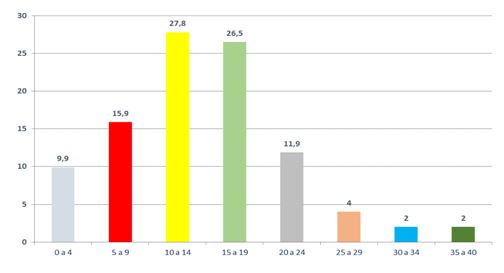
Graphic 3. Average number of athletes under training

The coach-athlete relationship data are eloquent, considering that 48.7% of the sample surveyed (graphic 3) train 1-8 junior athletes.
The total sums of athletes per coach, of those who work with 1-16 athletes extend to 58.6%. However, the rest of the coaches work with a higher number of runners, which jeopardizes the didactic equality: a coach with more than 16 athletes cannot give a rigorous attention to athletes.
However, if the coaches have several years of experience, are in a proper age and have a good relation with the athlete, why aren’t the results successful? From a technological perspective, it must be noted that 59,9% of the coaches don’t have digital pulsometers for the control and evaluation of the training load, in a sport where digital pulsometers are a very positive tool to reach that goal (graphic 4), although in regard to the previous question there is a coincidence with Calero (2014a,b) that the sport performance is the expression of several factors related, for which the analysis of the reasons why, should be based on a comprehensive interpretation of the process.
Graphic 4. Number of digital pulsometers available for the coaches

If taken into account the coach-athlete relationship, described in graphic 3, it should be noted that the pulsometers are not enough, since each athlete must use a digital pulsometer during training according to the individuality principle.
An aspect in which coaches agree is referred to the total of weeks in the annual macrocycle (graphic 5).
Thus 62.5% considers that the annual macrocycle should last 45 weeks, 23.5% defends 52 weeks of training and 11.2% says 40 weeks.
When analyzing the training program for junior long and middle distance runners in Cuba, the macrocycle lasts 45 weeks in relation with the school year.
Graphic 5. Weeks used in the annual macrocycle

85% of the coaches (131) agree in working from 45 to 52 weeks, these indicators are in tune with the competition schedule of the Ecuadorian Athletics Federation (FEA in Spanish).
Graphic 6. Training structure in the annual macrocycle
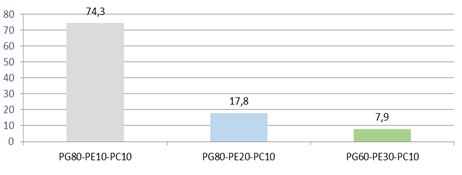
The graphic shows the percentage of the total of weeks for the General Preparation (PG), Special Preparation (PE) and the Competitive Preparation (PC), respectively.
In Ecuador, these categories should have a structure of 80% general period, 10% special period and 10% competitive period, which means that the coaches give more importance to the general period, which is carried out on a good basis in order to train the basic physical qualities, which will contribute to the physical formation towards a higher level in junior and senior categories.
Graphic 7. Load dynamics in the mesocycle

In the load dynamics, the coaches have the options to use these methods according to the principle of individuality. Those used the most are 1-1, 2-1, 3-1, which allow that the training loads go according to age and to the goal for the future of the athletes and confirm the results of Romero (2006) in the Program for the preparation of the Cuban athlete.
The coaches consider the use of the load dynamics a more adequate process to perform in the mesocycle per week 1-1, 2-1, 3-1 which is the equivalent to 94 coaches (61.8%).
Graphic 8. Training methods
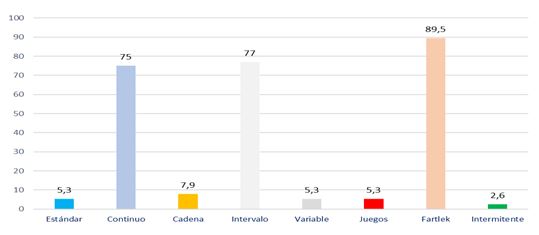
The training methods are related to the way coaches use the methodology in their plans. So the Fartlek method has 89.5% of acceptability, the Intervals method shows 77% and the continuous method 75%, which allows having a basis to develop necessary and basic needs of the middle and long distance runners, taking into account that in this category the intensity is an aspect to watch so as not to skip or burn training phases depending on the age of the athlete.
Graphic 9. Training systems for the development of aerobic resistance
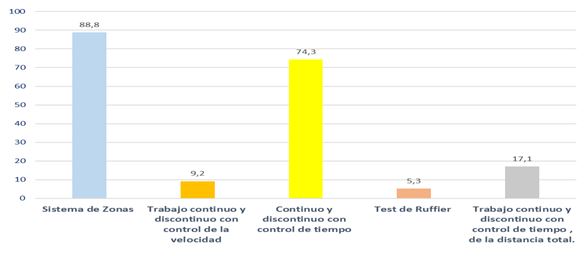
The most used training systems for the development of the aerobic resistance is the system of zones with 88.8% of acceptance and the continuous and discontinuous system with 74 %. The coaches follow these systems through the means they have to train and the geographic conditions.
The physical abilities define what type of training must be used, according to the need of the athlete. The coaches surveyed stated that the most applied ones are special resistance (lactic) 91.4 %; resistance to strength 86.8% and speed-force 86.2 %. According to these answers, the coaches pay more attention to the manifestations of resistance as physical ability: special resistance, resistance over distance and resistance to force, and also to speed-force.
Graphic 10. Distribution of the work with the physical abilities
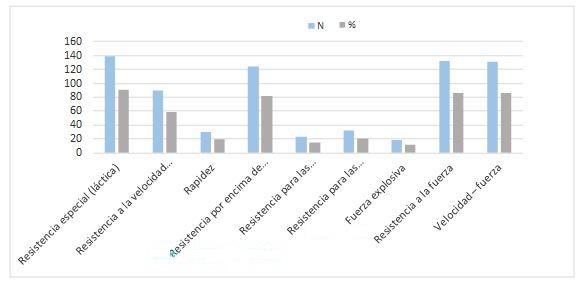
The distances recommended by the coaches are those regulated by the IAAF, for which Ecuador accepts the races included in international competitions such as middle distances: 400 meters, 800 meters and 1500 meters and long distances 3000 meters, 1200 meters steeplechase, 2000 meters for women. These are the distances recommended in Ecuador to develop official competitions.
Graphic 11. Competitive distance recommended for the coaches

Conclusions
-
The diagnosis study carried out with 152 middle and long distance coaches demonstrates that the criteria on the formation of a junior middle and long distance runners (13-15 years) is not homogeneous.
-
Ecuador counts on a great group of coaches with many years of experience, with shows their potential to successfully carry out the sport training with the junior runners.
-
The results show that the lack of a program to homogenize the athletic formation affects the continuation of an acceptable group of middle and long distances worldwide.
-
The paper describes key elements that take part in the planning process of the training at these ages in Ecuador.
Acknowledgements
-
The research project “Gestión de competencias para publicaciones científicas en estudiantes de pregrado y postgrado de la Universidad de las Fuerzas Armadas, ESPE”.
Bibliography
-
Álvarez de Zallas, Carlos. (1995). Metodología de la investigación científica. Santiago de Cuba, Universidad de Oriente.
-
Askew, E. W. (2002). Work at high altitude and oxidative stress: antioxidant nutrients. Toxicology, 180(2), 107-119.
-
Bigard, A. X., Brunet, A., Guezennec, C. Y., & Monod, H. (1991). Skeletal muscle changes after endurance training at high altitude. Journal of Applied Physiology, 71(6), 2114-2121.
-
Calero, S. (2013). Nuevas tendencias mundiales en el proceso de dirección del entrenamiento deportivo. Curso de Postgrado impartido en la Universidad de Guayaquil. Instituto de Investigaciones, Ecuador.
-
Calero, S. (2014a). Fundamentos del entrenamiento deportivo optimizado. Curso impartido en la Facultad de Educación Física, Deportes y Recreación de la Universidad de Guayaquil. Ecuador.
-
Calero, S. (2014b). Fundamentos del entrenamiento optimizado. Cómo lograr un alto rendimiento deportivo en el menor tiempo posible. Primer Congreso de Fisioterapia y Deporte. Universidad del Valle de México; Villahermosa, Tabasco, Estados Unidos Mexicanos.
-
Calero, S. y González, S. (2015). Preparación física y deportiva. Quito, Ecuador: Editorial de la Universidad de las Fuerzas Armadas ESPE. http://repositorio.espe.edu.ec/bitstream/21000/10201/1/Preparacion%20fisica%20y%20deportivaf.pdf
-
Campo, D. J. R., Sánchez, F. M., García, P. E., Arias, J. A. R., Albizu, S. M., & Díaz, J. F. J. (2012). Efectos fisiológicos inducidos por los programas de hipoxia intermitente. Archivos de medicina del deporte: revista de la Federación Española de Medicina del Deporte y de la Confederación Iberoamericana de Medicina del Deporte (149), 703-715.
-
Córdoba, A. y Martínez-Villé, G. (2001). Fisiología de la adaptación a la altitud. Editorial Gymnos.
-
Chapman, R. F., Stickford, A. S. L., Lundby, C., & Levine, B. D. (2014). Timing of return from altitude training for optimal sea level performance. Journal of Applied Physiology, 116(7), 837-843.
-
de Paula, J. M. P., Hidalgo, S. F., Toranzo, E. M., Doza, J. P., & de Paula, J. F. P. (2012). Alteraciones del equilibrio ácido-base. Diálisis y Trasplante, 33(1), 25-34.
-
Erdmenger Orellana, J. (2013). Valoración cardiovascular en niños y su relación con la altitud. Archivos de cardiología de México, 83(3), 183-184.
-
Girard, O., Amann, M., Aughey, R., Billaut, F., Bishop, D. J., Bourdon, P. et al. (2013). Position statement—altitude training for improving team-sport players’ performance: current knowledge and unresolved issues. British journal of sports medicine, 47 (Suppl. 1), i8-i16.
-
Girard, O., Koehle, M. S., Guenette, J. A., Verges, S., Chapman, R. F., Conkin, J. et al. (2012). Reduced air resistance with terrestrial altitude alters run sprint performance. Journal of Applied Physiology, 112(10), 1788-1794.
-
Gregorio Martínez y Alfredo Córdova. (2001). Fisiología especial. Editorial Gymnos, Madrid.
-
Hallagan, L. F., & Pigman, E. C. (2004). Altura: Aclimatación a Alturas Intermedias. PubliCE Standard.
-
Herrera, M. Á. A., & Díaz, J. C. M. (2006). Las deficiencias fisiológicas: intervención educativa en Educación Física. Lecturas: Educación física y deportes (103), 45. http://www.efdeportes.com/efd103/deficiencias-fisiologicas.htm
-
Insua, M. F. (2003). Conceptos actuales acerca del shuttle de lactato. Lecturas: Educación física y deportes (58), 22. http://www.efdeportes.com/efd58/lactato.htm
-
Jenkins, S. P. (2001). Sports science handbook. UK: Sunningdale Publications.
-
Lucía, A. (2000). La altura. Diario El País, España. 15 de julio de 2000. Fuente: www.santiquerol.arrakis.es/altura.doc (19 de febrero de 2006).
-
Pérez, A. (2005). Entrenamiento en altitud. Fuente: http://www.aamoratalaz.com/articulos/ENTALT05.pdf (7 de febrero de 2006).
-
Pérez, G. (2004). ¿Es bueno entrenar en altitud? Fuente: http://www.desnivel.com/tus_paginas/entrenamiento/object.php?o=10256&p=noticia.2/noticia.2.2.php&print= (10 de marzo de 2006).
-
Plowman, S. A., & Smith, D. L. (2013). Exercise physiology for health fitness and performance. Lippincott Williams & Wilkins.
-
Romero, E (2006). Programa de preparación del deportista de medio fondo y fondo. INDER, Cuba (soporte digital).
-
Rusko, H., Tikkanen, H., & Peltonen, J. (2016). Altura y Entrenamiento de Resistencia. PubliCE Premium.
-
Terrados N, Mizuno M, Andersen H. (1994). "Reduction in maximal oxygen uptake at low altitudes. Role of training status and lung function." Clin Physiol Oxf.; 5(Suppl. 3):75-9.
-
Venegas P. (1999). Ejercicio y entrenamiento en altitud". En Nutrición, Fisiología y Ejercicio en Altitud. M. Sandoval y J. Bravo, Eds. Santiago de Chile.
-
Virués-Ortega, J., Garrido, E., Javierre, C., & Rivero, P. (2008). Funcionamiento neuropsicológico bajo condiciones de hipoxia aguda y crónica asociada a la altitud. Arch Biol Andina, 14(1), 40-50.
-
Wikipedia (2015). Jerzy Hausleber. Wikipedia, La Enciclopedia Libre. https://es.wikipedia.org/wiki/Jerzy_Hausleber
-
Wilber, R. L. (2004). Altitude training and athletic performance. Human Kinetics.
-
Yang, R., Yin, J., Qian, y., & Jiang, L. (2015). A Preliminary Study on Effect of Plateau to Sub-plateau to Plain Transition Training on Performance of Native Plateau Middle and Long Distance Runners' Cardiopulmonary Function. Sichuan Sports Science, 3, 008.
Another articles in English

|
|
|---|---|
|
EFDeportes.com, Revista Digital · Año 21 · N° 219 | Buenos Aires,
Agosto de 2016 |
|